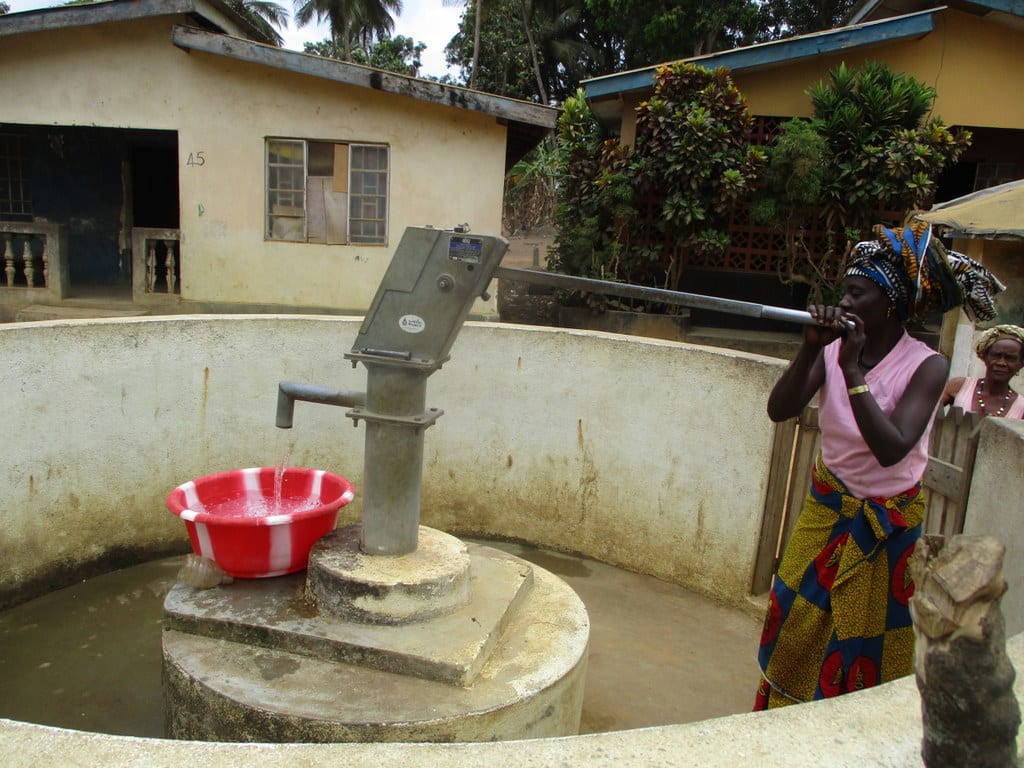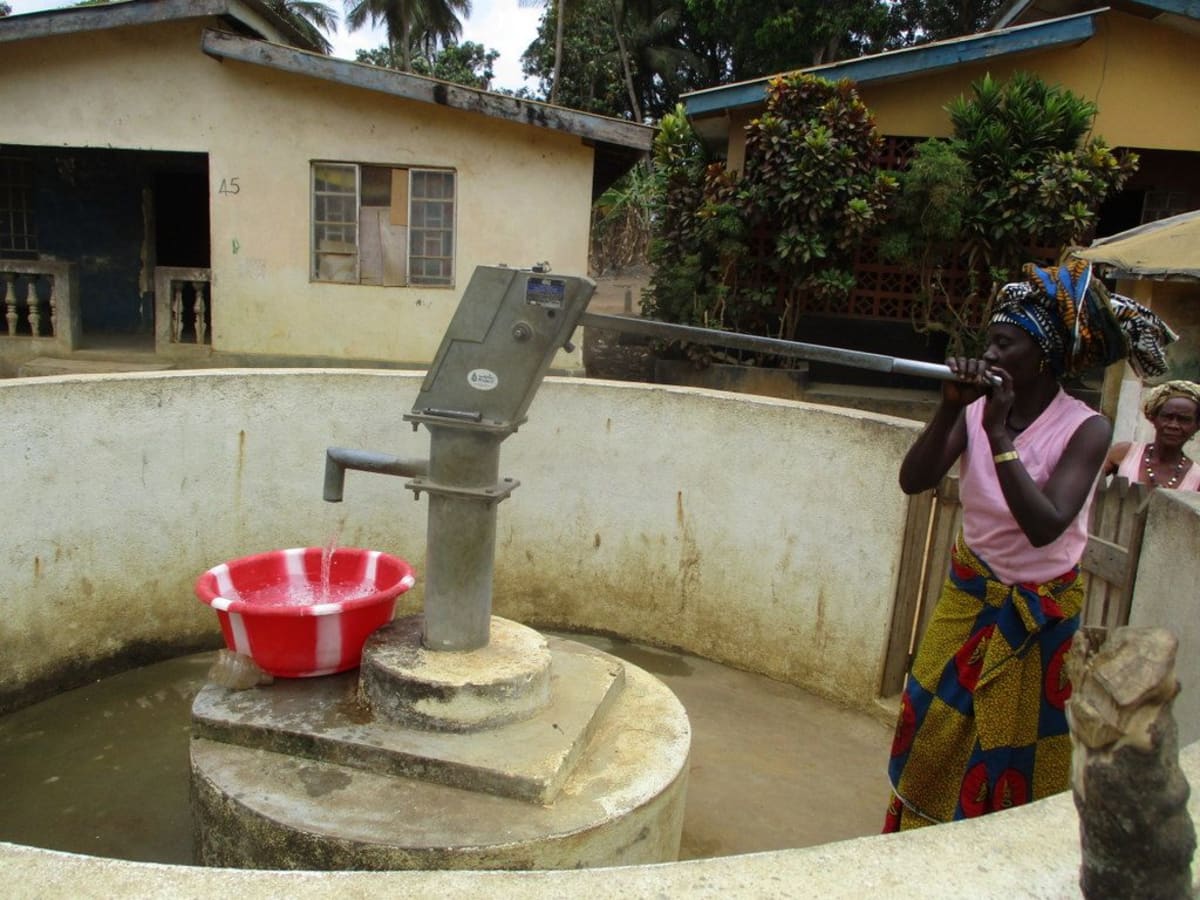May, 2018: Tholmosor Community, Alpha Dabola Road Project Complete
We are excited to share that there is a safe, reliable water point in Tholmosor Community, already providing clean water to families! People here no longer have to rely on dirty water from the swamp. Hygiene and sanitation training was also conducted, which focused on healthy practices such as washing hands and using latrines.

New Knowledge
This training took a different approach, unlike the usual Hygiene and Sanitation trainings.
A work plan was prepared. This was a combined training for Tholmossor, Yongoroo, and Kamem communities which was a one-day training with different activities. The planning started with an engagement with the Section chief Pa Alimamy Kargbo Kapen and several consultative meetings were held with the communities involved. A day before the training, a football match took place that attracted many people from the community - providing the opportunity to raise awareness about the event.

The venue for this meeting was Saint Ann Primary School Compound. The compound is not paved and we are currently in the dry season, therefore, we suffer a great deal from dust.
The training was a success!
The agenda was so organized that, there was little or no room for the participants to engage in any other activity. All of the topics discussed had something to do with their everyday life and that interests them the most.

Learning to make handwashing stations
This was a very big program with very strict agenda. The participants got very involved with hands-on activities and games, but remainded quiet and respectful as they listened to the information presented by our trainers.
"This training will change even the lives of the most stubborn people present here today.," Mr Pa Ensa Mamoud said.

Handwashing demonstration
Dramatizing the hygiene training is new in Mariatu’s Hope. Nevertheless, it was done to perfection and the audience appreciated it very much. What happened was that they made the juxtaposition of good and bad hygiene into a drama. A team member lived in a very dirty compound with open defecation and settled water all around the compound. He falls sick and was taken to the hospital.

The comedy-drama in action
The message was well presented in a drama-comedy form and at the end of the exercise, the audience gave a huge round of applause. The applause proved the audiences’ comprehension and appreciation of the message.

The acting troupe!
Puppets were used by school kids to teach community people about their environmental sanitation. This method also not only caught the attention of kids around, but even elderly people appreciated the puppets.

Of course, puppets are mostly liked by kids. The school population displayed the highest amount of interest when this show was on. Some kids wanted to find out who actually was behind the puppets.

But what was most surprising was the interest we noticed among even the elderly people in seeing the puppets. The puppet show almost stole the entire training!
"We now know the difference between good and bad hygiene. Most of our bad hygiene practices were due to ignorance," Mr. Mamoud said.
"With this training, I think our attitude towards hygiene will improve drastically. In fact, I am going to ensure that we pass laws in these communities that will help complement your effort."
Clean Water Restored

Finished pump!
The team of three artisans set up their camping gear near the water point and performed the necessary checks on equipment to get them ready for the next day’s operation. The proceeded to rehabilitate the existing well.
This is how it was done:
Socketing the pipes
Because the sizes of the original sockets are not always appropriate, fire is set to heat pipes that will be used to improvise sockets. The heated pipe fits into the other pipe so that it further opens to create an improvised socket.
Fixing the tripod
Three metal pipes are connected to make a single pod, there are nine of those needed for a tripod. A rope is then passed through a pulley attached to the top end of the tripod. This rope is tied to the bucket auger drill bit to the drilling rod and lowered inside the temporary casing to the bottom of the well.

Finding depth
After the installation of the tripod, the static level and total depth are established. For these levels, the team uses a drop line that has a metal tied to one end. This line is dropped into the well and tied at the frame of the well to indicate the total depth of the well. But from the tied portion of the line to the watermark is the static level. If you subtract the static level from the total depth, you get the water quantity.

Installation of casing pipes
A 6" casing pipe is fitted into an iron plank and riveted for a firm grip. A nut is then slacked from the plank and a rope tied to the 6" socket is pulled to allow the pulley to easily lower the pipe into the well. A strong board is laid on top of the pipe and forcefully hit to let it sit tight at the base of the well.

Lining up of drilling rod
These rods are numbered and connected accordingly. A rope is tied to the end of the last rod which will be pulled and released instantaneously so that the drilling bits will dig a borehole into the soil down the well.

Drilling
Firstly, the team has to remove the well hatch cover and lower a temporary 6" PVC pipe through the open hatch to the bottom of the well. They then connect the bucket auger drill bit to the drilling rod and lower it inside the temporary casing to the bottom of the well.
Each of these drilling rods is 18 feet long. Team members have to pull a rope through a pulley to raise the rods out of the casing so two men can empty the bucket auger. This process continues and the 6" casing pipe is occasionally hammered down in order to keep the borehole straight.
During drilling, the team encountered clay of two colors which signaled a tough task ahead. They continued drilling and in about two feet, they reached the sand, which is a good sign of water but associated with the possibility of a hole collapsing during drilling.

But this drilling method allows the team to install the hand pump cylinder far below the aquifer. Which means that the community will have a very good access to water. And because the team feared that the pump might encounter debris or sand, because the hole was a little sandy, they suspended the cylinder to two feet above the bottom of the well.

Flushing the well
Screening
4" casing pipes are laid out to the requisite depth of the well. The casing pipes are the screened, that is, the pipes are given slight slices to make a passage for water. The pipe is then wrapped with empty rice bags all in the bid to help filter any debris.

This screened pipe is slotted into casing pipes and is lowered into the well. About 5 buckets of sand mixed with small stones, called filter packs, is poured in between the two casings. A chain hoist is set up to pull out the temporary casing, leaving the 4' pipe at the bottom of the well.
Iron rod support
This process requires that iron rod is cemented to the well lining and attached to the casing to support the weight of the PVC and keep it straight from the bottom of the well to the top of the pump base. They weld a collar into the pump base to help support the casing.

Bailing and Yield testing
The hand bailing system requires two people to bail by hand. It is bailed out for three days. It is then yield tested by installing an electrical submersible pump to the depth of the well and pumping for about thirty minutes. They continue pumping for another hour while measuring the amount of water pumped out. They were relieved after the yield test.

Safe Water
The dedication took place in the morning. We sent a message ahead of time to the chief informing him of our visit. By the time we arrived, we met a lot of people around the well area waiting for us.

The adults were called to gather around the well, while the kids were instructed to enter the tap area. They were then reminded of the purpose of the visit.
After that, we engaged them with our usual praise and worship which they were now accustomed to. They then showed a sign of appreciation to the donors with their traditional songs. Photos and short videos were taken it was fun and laughter.

The section chief and headman had to make statements with thanks given messages to the donors and also words of admonishment to the community people.

"This well is a blessing to this community. What I am imagining right now is how much lives Mariatu’s Hope have saved because of providing this water well for this community," Mr. Pa Alimamy Kapen Kargbo said.
"Yesterday when I looked at the well and reflect on the past when my people would have to go to the swamp to fetch drinking water, I said thanks to God."


 Protected Dug Well
Protected Dug Well









































